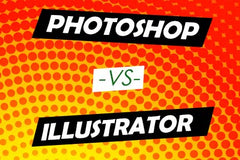The types of images that you use to create artwork for screen printing matter. For that matter you need to understand the difference between raster and vector graphics. You need to understand this concept because you may need to teach future employees or your own customers what these concepts are. It can be the difference between having a great design and one that is blurry.
Raster Images
What is a raster image? A raster image is an image that is made from combining a lot of pixels (tiny dots of colors) together. Think of a raster image as a photo. This would be the sort of thing that you would create with a camera or a phone.
Raster images begin to blur when you enlarge the picture. They get sharper and clearer when you shrink the image down. When a raster image is created it has a lot of pixels. The more pixels it has, the sharper the image is. This can create large file sizes.
Typical file types for raster images include .jpg, .png, .bmp, .gif, and .psd. The most common editing programs for a raster image are Photoshop and Lightroom. However, if you don’t have either of these then you can use the free program Gimp. Any of these will allow you to make changes to your raster images.
Vector Images
What is a vector image? A vector image is an image that is made using mathematical principles. An algorithm creates shapes, curves, and lines. Don’t worry, you don’t have to create the algorithm. It is created for you when you design the image. Because the image is created with mathematical principles means that changing the size of the image won’t alter the look of the image. It won’t become blurry or sharp when you change the size of it. When you alter one of the variables in a mathematical principle the other variables respond accordingly and that in turn changes the algorithm. So it won’t matter what the size of the images is, the other parts of the algorithm will respond accordingly.
Typical file types for vector images include .ai, .eps, and .svg.
Rasterizing and Vectorizing
When you have a raster image, but you need a vector image you vectorize the image. When you need a raster image, but you have a vector image you rasterize the image. Ultimately you are converting one image type into the other image type. When it comes to dtg printing you will most often use the process called vectorization.
What this means is that you are going to take a photograph and convert it into a vector (mathematical) graphic. Then you will be able to shrink and enlarge the photo as needed.
The final word on Raster and Vector Images
Once you understand the difference between the two concepts you will be able to begin working with both types of images. It may take time to understand how to work with each of the graphic images, but you will at least understand the difference between the two.




Leave a comment